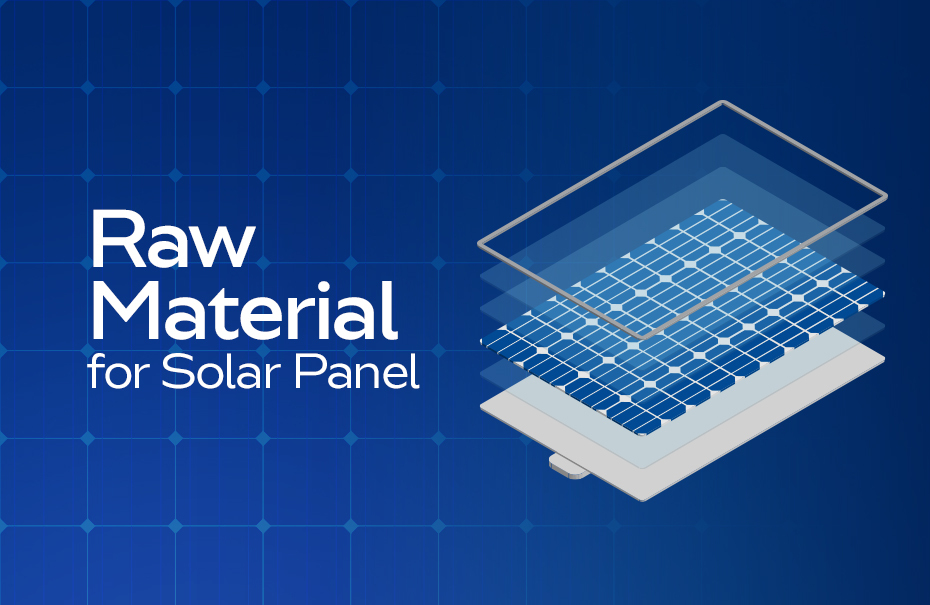Raw Material for Solar Panel: Regardless of the Type

Have you ever wondered how solar panels are made? What raw materials are used in manufacturing these innovative energy harvesters that adorn rooftops and power vast solar farms which are known as solar panels? The journey from sunlight to creating electricity with the help of solar panels is quite interesting, and its core lies in the selection of the raw material for solar panel manufacturing.
From the sleek monocrystalline panels to the economical polycrystalline options, the innovative Passivated Emitter and Rear Cell (PERC) panels, and the easily installable thin-film varieties, each type of solar panel uses the power of sunlight in its unique way. Yet, regardless of the type of solar panel that you choose, there’s a common thread that weaves them together – and that is the raw materials that constitute their foundation. Whether you opt for monocrystalline, polycrystalline, PERC, or thin-film panels, you’ll find that the building blocks that make these panels tick are remarkably alike.
In this article, we’ll delve into the essential components that come together to create solar panels, shedding light on the raw materials that drive the solar energy revolution.
Raw Materials Used for Making Solar Panels
Solar Aluminum Frames
The most crucial components of creating solar panels are the sturdy solar panel frames that hold the entire structure together. These aluminum frames provide structural support and also protect the delicate solar cells from within. They provide necessary stability to the overall combination of Glass, Solar Encapsulant, Solar Cell, and Back Sheet.
You may wonder why aluminum. Well, it’s because they are light in weight, corrosion-resistant, and durable properties, ensuring that solar panels can withstand the test of time and weather the elements. By providing a reliable foundation, aluminum frames enable solar panels to maintain their efficiency and longevity. They are recycled and also cost-effective.
Solar Encapsulants
Solar Encapsulants play a vital role in safeguarding the solar panels against external factors such as moisture, dust, and physical damage. They are applied on both sides of the solar cells, which ensures their protection. Often made of ethylene-vinyl acetate (EVA) or similar materials, these solar encapsulants seal the solar cells within the panel helping prevent any external elements from compromising the performance of solar panels.
Not only do they provide a protective shield to the panels, but they also enhance the efficiency of solar panels by reducing reflection losses.
Solar Backsheets
Similar to solar encapsulants, solar backsheets act as the first line of defense for solar modules. Positioned at the back of the solar panel, these sheets shield the delicate components from moisture, physical or electrical shocks and UV rays, which increases the durability of the panel.
Manufacturers often utilize specialized materials that possess high resistance to temperature changes, UV radiation, and environmental stressors. This ensures that the solar panels can perform optimally, even in challenging conditions.
Glass
The front cover of a solar panel is typically made of tempered glass, known for its transparency, durability, and ability to withstand extreme weather conditions. This transparent layer allows sunlight to pass through while offering protection to the underlying solar cells. Tempered glass is used for its strength, ensuring that the panels can endure mechanical stress and impact without compromising their performance.
Start your solar journey today with Vishakha Renewables
With a commitment to sustainable energy solutions, Vishakha Renewables stands as the largest producer of the raw materials used in manufacturing solar panels. Their dedication to quality and innovation ensures that solar panels are crafted using the finest materials, setting the stage for efficient and long-lasting solar energy generation.
We are the leading providers of solar panel solutions in India. As the foremost producer of solar panel components, we are specialized in crafting solar panel materials such as Solar Aluminum Frames, Solar Encapsulants, Solar BackSheets, and Glass. These components play a vital role in creating solar panels that harness limitless solar energy and convert it into clean, sustainable power.
Wrapping Up
The manufacturing of solar panels is a remarkable feat of contemporary technology,, and at its heart lies a selection of raw materials that define their quality, performance, and endurance. From the aluminum frames to the protective encapsulants, backsheets, and tempered glass, each material plays a unique role in transforming sunlight into usable energy. As solar energy continues to play an important role in our transition to a sustainable future, understanding the significance of these raw materials underscores the importance of investing in high-quality solar panels, just as offered by Vishakha Renewables. So, if you’re considering embracing solar power, rest assured that a blend of these materials will be harnessing the sun’s energy to power your life.
FAQs Regarding Raw Material for Solar Panel
1. What is one of the main ingredients of solar panels?
One of the main ingredients of solar panels is Silicon that are specifically in the form of photovoltaic cells, which convert sunlight into electricity.
2. Where are the materials for solar panels found?
The materials for the solar panel are sourced from quartz sand, which is abundant in the Earth’s crust, and also from recycled electronic components and manufactured polysilicon.
3. Which metal is used in solar panel?
Aluminum is the most common and preferred metal for making solar panels as it is lightweight, it has corrosion resistance, and ability to dissipate heat effectively.
